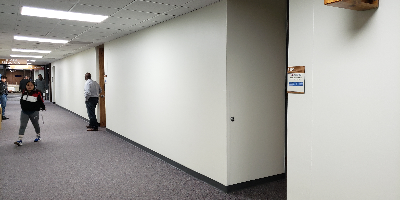aug 15, 1870 - First time the country was connected by rail
Description:
(Photo: Famous Kansas Pacific Photograph by Robert Beneke shows employees posing with seven diamond stacked 4-4-0's and one 0-4-0 at the Armstrong roundhouse in Wyandotte circa 1874. Southern Methodist University DeGolyer Library.)August 15, 1870, The Kansas Pacific and Denver Pacific Railway meet at Strasburg Junction near Denver, Colorado the first time the country was technically connected by rail from coast to coast. Dutch and German investors helped the Kansas Pacific finish the final connection with the Denver Pacific at what became known as Strasburg Junction. This was not actually a town but a point on the map that today has a railroad history museum. It was technically at this point in time that the country was connected by rail from coast to coast because: 1) a ferry was being used to transport the train across the Missouri River from Council Bluffs to Omaha; 2) Denver was already connected to the main line in Cheyenne: 3) the Hannibal Bridge was completed across the Missouri River into Kansas City, Missouri in 1869; and 4) there was a railroad bridge spanning the Kaw River from Kansas City, Missouri to Wyandott. Therefore, the Golden Spike celebration at Promontory, Utah, dedicated to the completion of the Transcontinental Railroad on May 10, 1869, was conditional. In the end, the two competing routes to the west led to famed railroad and Civil War photographer Alexander Gardner’s phrase “Westward the Course of Empire Takes It’s Way” (Aspinwall).
Jay Gould a Union Pacific investor gained control of the Kansas Pacific in 1874 and consolidated it with the Denver Pacific and eventually the entire Union Pacific in 1880. The completion of Hallett and Perry’s vision of a second transcontinental line all the way to San Francisco didn’t take place until 1934 with completion of the Dotsero Cutoff through the Rockies.
Edward H. Harriman purchased the Union Pacific at an auction after it had fallen into bankruptcy on November 1, 1897. He began a $25 million dollar rebuilding that was completed in time for the start of World War I that included upgrades at the Union Pacific yards including the metal bridge at Armstrong and along the main line through Wyandotte County. Harriman transformed the company into the most reliable railroad in the nation during World War I.
In the 1890s a large number of Croatians settled in an area called “The Patch” along the Union Pacific Railroad which had a switching yard at Armstrong. The flood of 1903 forced many up to the top of what is Strawberry Hill in downtown Kansas City, Kansas. Many people in this diverse ethnic neighborhood found work at the Union Pacific and Rock Island Railroads that had switch yards on the north side of the Kaw River Valley.
In 1905 The Union Pacific began transcontinental service to Los Angeles, California which brought a boost in passengers heading through Kansas City, Kansas. In 1934 the first passenger streamliner “The City of Salina” was operated by the Union Pacific traveling the Wyandotte County countryside at 110 miles per hour. In 1941 the Union Pacific put into service the most powerful steam engine ever built, the 4-8-8-4 “Big Boy.” In World War II the Union Pacific moved more freight and troops than ever before from Fort Riley through Kansas City Kansas.
Added to timeline:
Date:
aug 15, 1870
Now
~ 155 years ago
